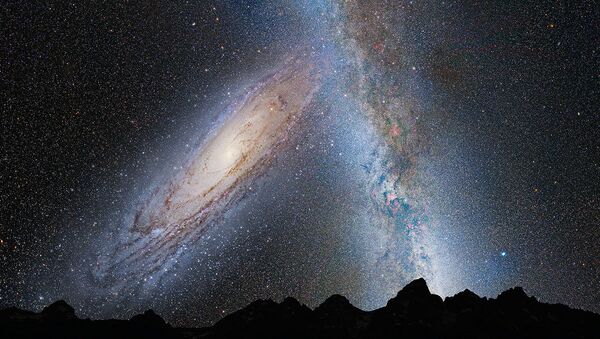Sputnik: What struck you as most mind-boggling about it?
Daniel Bayliss: We made this discovery by monitoring hundreds of thousands of stars from the telescopes that we have in Chile and we were looking for small dips in the star’s brightness when a planet passed in front of it. We were very surprised with this particular discovery because it looked like it was a very large planet. We took bigger telescopes to confirm that and sure enough it turned out that this planet was about the size of Jupiter, even though it was orbiting a very small star. That was really something we didn’t expect to find.
Sputnik: What could be a possible explanation for the configuration of this?
Daniel Bayliss: Perhaps we were just lucky and these very rare objects need perfect conditions for them to form at the start of their lives. Or perhaps we have got something wrong with our theory, and maybe these types of massive planets can quite easily form around small stars.
Sputnik: How does this discovery affect and change the scientific view on astronomical processes? Does it change it?
Daniel Bayliss: Yes, it changes the way we think planets form. We are still not 100 percent sure how planets form. We know they are quite common in the galaxy now and most stars have planets going around them, but we thought that small stars should really be only forming small planets. So we will need to change the way we think about how planets form to make sure that we can still work out how a planet like this can form around a small star.
Sputnik: What is your strategy when you discover these planets, what are you trying to do?
Daniel Bayliss: We hope we will find many more planets similar to this one. What we are doing that is a little different from what has been done in the past is that we are monitoring these stars in very red lights, so we have new cameras on these telescopes, which are state-of-the-art cameras, which can monitor very red light. What that means is that we can now monitor “red dwarfs” – these are small stars, whereas in the past they were quite difficult to monitor. So what I was able to do is start looking for how these planets form around these small stars. So now you might ask why that is so interesting. Actually most of the stars in our galaxy are small stars so about 75 percent of all stars in our galaxy are actually red dwarf like stars. So if we can work out what type of planets they have going around them, they will be actually surveying most of the planets in our galaxy.
Sputnik: Perhaps you could enlighten us about what your next and further steps are going to be in regard to this specific discovery? What are you now trying to understand and how does this actually affect human kind?
Daniel Bayliss: With this particular discovery there are still quite a few things we don’t know. For example, we don’t know the exact composition of this planet. So we are going to be using larger telescopes and we are going to try to understand more about this planet and that might give us more clues about how it formed. In terms of the next steps though, if you could discover Jupiter-sized planets eventually what we really want to be able to do is to discover a planet like the earth. So a small rocky planet that orbits a star, like our own sun … where we could have liquid water, because we know that those types of conditions can lead to life, at least in one case here on Earth. Over the next 10 years we are actually going to be working on a mission called PLATO, that’s going to be on a telescope in space and from space we can have enough precision to actually find a planet just like the earth.
Sputnik: Can you see terraforming another planet in our lifetime? In a scenario where human beings are actually living and capable of continuing development of human life on a different planet?
Daniel Bayliss: That is wonderful to think about. Most of the planets that we find are too distant from us to travel to in our lifetimes. But of course in the solar system the scales are much shorter, so, for example, going to Mars I think would be fantastic. Terraforming may take resources and technology beyond what we have right now, but the first step would be exploring that planet and I think that could happen in our lifetime.
Dr. Daniel Bayliss is an assistant professor in the Astronomy and Astrophysics group at the University of Warwick. He completed his PhD at Mt Stromlo Observatory in Australia. After a five-year post-doc in Australia he moved to Switzerland where he had worked at Geneva Observatory over the last three years. Currently he has joined a team in Warwick to work on the PLATO project.




